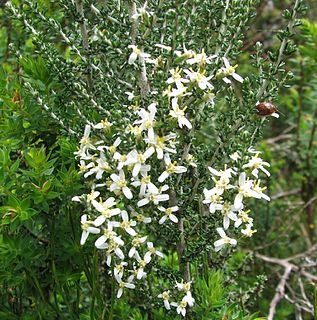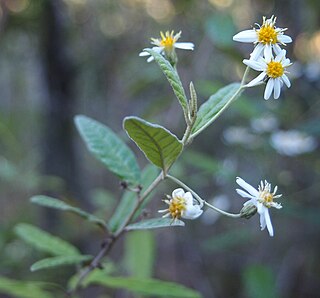
Olearia axillaris, commonly known as coastal daisy-bush, coast daisy-bush or coastal daisybush is a species of flowering plant in the family Asteraceae and is endemic to coastal areas of Australia. It is an erect, bushy shrub with densely cottony-hairy branchlets, aromatic, linear to narrowly elliptic or narrowly lance-shaped to egg-shaped leaves with the narrower end towards the base and small white and yellow, daisy-like inflorescences.

Olearia algida, the alpine daisy-bush is a species of flowering plant in the family Asteraceae and is endemic to south-eastern Australia. It is a shrub with small, crowded, elliptic to narrow egg-shaped leaves with the narrower end towards the base and heads of white and cream-coloured, daisy-like flowers.

Olearia megalophylla, commonly known as large-leaf daisy bush, is a species of flowering plant in the family Asteraceae and is endemic to south-eastern continental Australia. It is a spreading shrub with egg-shaped to elliptic leaves and white and yellow, daisy-like inflorescences.

Olearia tomentosa, commonly known as the toothed daisy-bush, is a species of flowering plant in the family Asteraceae and is endemic to south-eastern continental Australia. It is a spreading shrub with egg-shaped leaves, the edges toothed or lobed, and blue or white and yellow, daisy-like inflorescences.

Olearia covenyi is a species of flowering plant in the family Asteraceae and is endemic to New South Wales. It is a shrub with scattered egg-shaped leaves, and white and yellow, daisy-like inflorescences.

Olearia glutinosa, commonly known as sticky daisy-bush, is a species of flowering plant in the family Asteraceae and is endemic to south-eastern Australia. It is an erect, bushy, glabrous shrub with linear leaves and mauve, pink or white and yellow, daisy-like inflorescences.

Olearia canescens is a species of flowering plant in the family Asteraceae and is endemic to eastern Australia. It is a shrub with scattered elliptic or egg-shaped leaves, and white and yellow, daisy-like inflorescences.

Olearia myrsinoides, commonly known as silky daisy-bush or blush daisy bush, is a species of flowering plant in the family Asteraceae and is endemic to south-eastern Australia. It is a spreading shrub with hairy branchlets, egg-shaped to elliptic leaves with toothed edges, and white and yellow or mauve, daisy-like inflorescences.

Olearia iodochroa, commonly known as the violet daisy bush, is a species of flowering plant in the family Asteraceae and is endemic to south-eastern continental Australia. It is a shrub with branchlets densely covered with whitish hairs, narrowly egg-shaped leaves with the narrower end towards the base, and white or mauve, and cream-coloured, yellow or blue, daisy-like inflorescences.

Olearia pannosa, commonly known as silver-leaved daisy or velvet daisy-bush, is a species of flowering plant in the family Asteraceae and is endemic to south-eastern continental Australia. It is a spreading undershrub or shrub with egg-shaped or heart-shaped leaves, and white and yellow daisy flowers.

Olearia exiguifolia commonly known as small-leaved daisy bush, is a species of flowering plant in the family Asteraceae and is endemic to south-western Australia. It is an erect or straggly shrub with broadly egg-shaped leaves with the narrower end towards the base, and white and yellow, daisy-like inflorescences.

Olearia muelleri, commonly known as Mueller daisy bush, Mueller's daisy bush or Goldfields daisy, is a species of flowering plant in the family Asteraceae and is endemic to southern continental Australia. It is a compact or spreading shrub with scattered spatula-shaped to egg-shaped leaves with the narrower end towards the base, and white and yellow, daisy-like inflorescences.
Olearia burgessii is a species of flowering plant in the family Asteraceae and is endemic to south-eastern New South Wales. It is a shrub with scattered elliptic to egg-shaped leaves with the narrower end towards the base, and white and yellow, daisy-like inflorescences.
Olearia cuneifolia is a species of flowering plant in the family Asteraceae and is endemic to Queensland. It is an erect shrub with lance-shaped to wedge-shaped leaves and white, daisy-like inflorescences.
Olearia fluvialis is a species of flowering plant in the family Asteraceae and is endemic to inland areas of northern Western Australia. It is a shrub with scattered, narrowly egg-shaped leaves, and white or mauve and yellow, daisy-like inflorescences.

Olearia frostii, commonly known as Bogong daisy-bush, is a species of flowering plant in the family Asteraceae and is endemic to Victoria in Australia. It is a low, often straggling shrub with egg-shaped leaves with the narrower end towards the base, and mauve to pink and yellow, daisy-like inflorescences.
Olearia gravis is a species of flowering plant in the family Asteraceae and is endemic to south-eastern Australia. It is a shrub with elliptic or egg-shaped leaves and white and yellow, daisy-like inflorescences.
Olearia heterocarpa, commonly known as Nightcap daisy bush, is a species of flowering plant in the family Asteraceae and is endemic to eastern Australia. It is a shrub with narrowly elliptic or lance-shaped leaves with toothed edges, and white and yellow, daisy-like inflorescences.

Olearia humilis is a species of flowering plant in the family Asteraceae and is endemic to the south-west of Western Australia. It is an erect, spindly shrub with narrowly egg-shaped or linear leaves, and purple and yellow, daisy-like inflorescences.
Olearia macdonnellensis is a species of flowering plant in the family Asteraceae and is endemic to a restricted part of the Northern Territory of Australia. It is an erect, bushy shrub shrub with broadly elliptic to broadly egg-shaped leaves and yellow, or white and yellow, daisy-like inflorescences.













